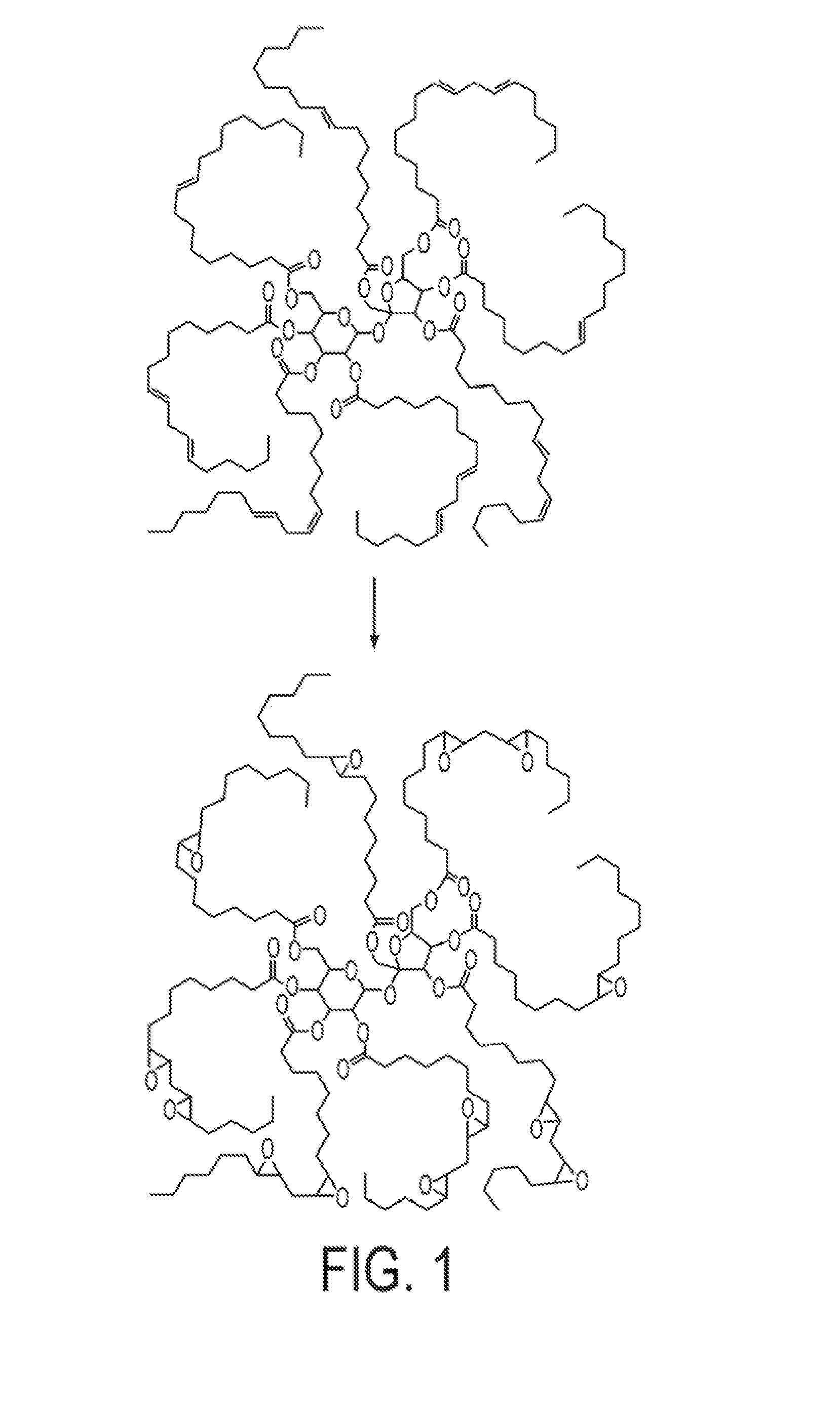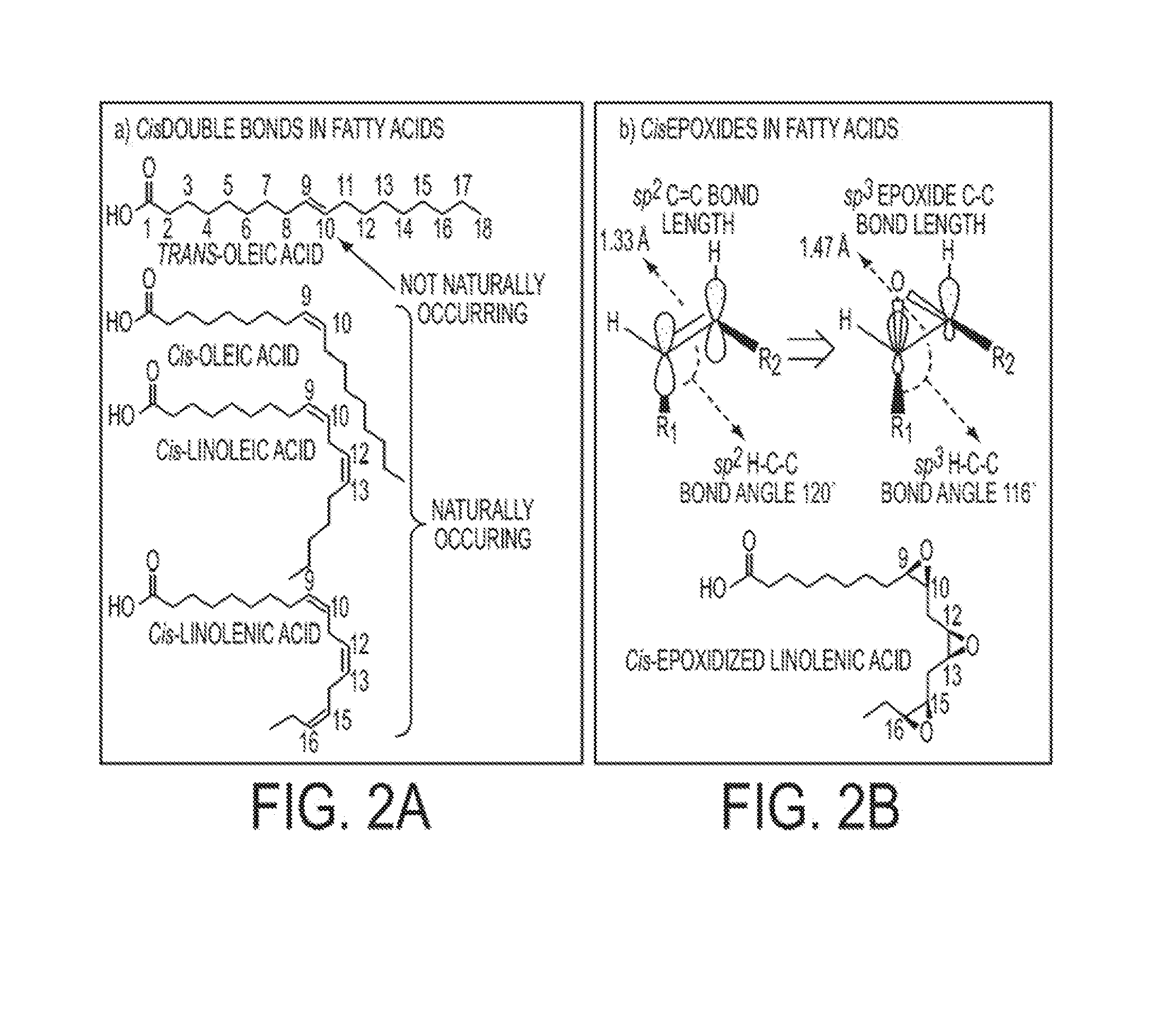Highly functional epoxidized resins and coatings
a technology of epoxidized resins and coatings, applied in the direction of coatings, polyurea/polyurethane coatings, organic chemistry, etc., can solve the problems of resins that have not been commercialized and the maximum degree of substitution (ds) was limited, and achieve excellent pigment wetting power and low cost
- Summary
- Abstract
- Description
- Claims
- Application Information
AI Technical Summary
Benefits of technology
Problems solved by technology
Method used
Image
Examples
example 1
Preparation of Epoxidized Sucrose Esters (ESE) of Fatty Acids
[0086]1.1 Starting Materials:
[0087]The sucrose esters of fatty acids (SEFA's) were received from Procter & Gamble Chemicals (Cincinnati, Ohio). Acetic acid (ACS reagent, 99.7%), diethyl ether (ACS reagent, ≧99.0%), hydrogen peroxide (50 wt % solution in water), Amberlite IR-120H ion-exchange resin, sodium carbonate (ACS reagent), and anhydrous magnesium sulfate (reagent grade, ≧97%) were purchased from Sigma-Aldrich, Inc. (St. Louis, Mo.). All materials were used as received without further purification.
[0088]1.2 Method:
[0089]Four SEFOSE sucrose esters derived from different vegetable oils (Table 1) were epoxidized using peracetic acid generated in situ from hydrogen peroxide and acetic acid, in the presence of Amberlite IR 120H as catalyst using the method described below for the epoxidation of sucrose linseedate. Table 3 lists the sucrose esters of fatty acids. The epoxidation reactions were carried out in a 500 mL four-...
example 2
UV-Curable Coating Formulations of Epoxidized Sucrose Esters of Fatty Acids
[0097]2.1 Materials and Methods:
[0098]The epoxidized sucrose linseedate (ESL), epoxidized sucrose safflowerate (ESSf) and epoxidized sucrose soyate (ESSy) were synthesized following the method in Example 1. UVR 6110, 3,4-epoxycyclohexylmethyl-3,4-epoxyhexane carboxylate, UVI 6974, a mixture of triarylsulfonium hexafluoroantimonate salts were obtained from Dow Chemical Company, USA. Oxt-101, 3-ethyl-3-hydroxymethyl oxetane (TMPO) was supplied by Togoasei America Inc. Epoxidized soybean oil (ESO) was procured from Arkema, USA. The properties of ESL, ESSy, ESSy and ESO are shown in Table 5.
TABLE 5Viscosity and Epoxy Equivalent Weight of ESEs and ESOEpoxy EquivalentEpoxyViscositySampleWeight (g / mole)groups / mole(mPa · s)ESL183.3114.188000ESSf229.5611.335100ESSy252.1910.312190ESO243.524.4972
[0099]2.2 Coating Formulation:
[0100]The coating formulations are listed in Table 6. All formulations contained a cationic phot...
example 3
Acrylation of an Epoxidized Sucrose Ester of a Fatty Acid
[0104]3.1 Materials:
[0105]Epoxidized sucrose soyate (ESSy) was prepared as in Example 1. Ampac Fine Chemicals provided AMC-2 Accelerator. Isodecyl acrylated (IDA) and 1,6-hexanediol diacrylate (HDODA) were obtained from Sartomer, while 2-hydroxyethyl acrylate (HEA) was purchased from Sigma-Aldrich. Darocur® 1173 photoinitiator was purchased from Ciba. Ebecryl 860, an acrylated epoxidized soybean oil, was obtained from Cytec.
[0106]3.2 Synthesis
[0107]The epoxy equivalent weight of the Epoxidized Sucrose Soyate (ESSy) was determined to be 248.79 g / mol. Acrylated resins were prepared having three different extents of acrylation (based on the number of epoxy groups). Table 8 contains the amount or reagents used for the acrylation of ESSy. AESSy is the fully acrylated resin, while PAESSy 50 indicates that 50 percent of the epoxy groups were acrylated and PAESSy indicates that 75 percent of the epoxy groups were acrylated.
TABLE 8Acry...
PUM
 Login to View More
Login to View More Abstract
Description
Claims
Application Information
 Login to View More
Login to View More - R&D
- Intellectual Property
- Life Sciences
- Materials
- Tech Scout
- Unparalleled Data Quality
- Higher Quality Content
- 60% Fewer Hallucinations
Browse by: Latest US Patents, China's latest patents, Technical Efficacy Thesaurus, Application Domain, Technology Topic, Popular Technical Reports.
© 2025 PatSnap. All rights reserved.Legal|Privacy policy|Modern Slavery Act Transparency Statement|Sitemap|About US| Contact US: help@patsnap.com



